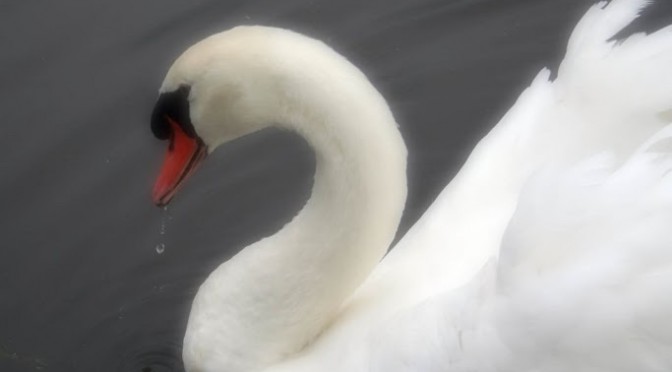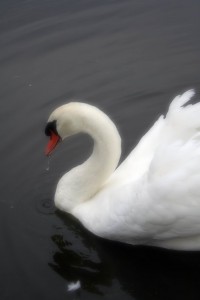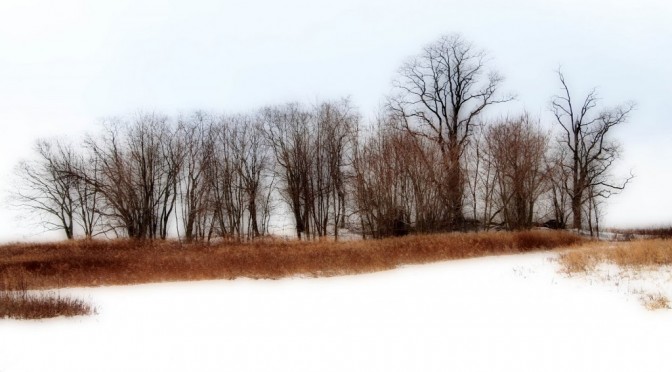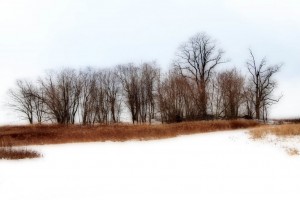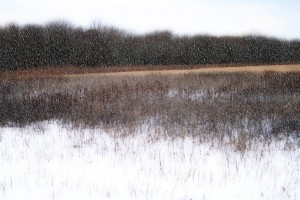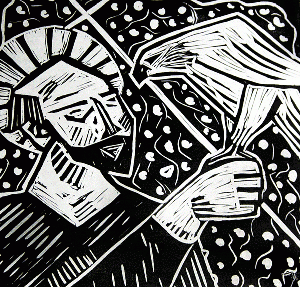 I’ve posted about this before, but it’s worth repeating for those of you who might not be familiar with the site. Lincoln Karim maintains a website that chronicles the life of NYC’s most famous red-tailed hawk – Pale Male. His photography is stunning and he really, really loves these birds. Pale Male is a movie star (a documentary was made about him) and he was the subject of a book (Redtails in Love). In late 2004 his nest on a swanky building in NYC was removed and destroyed by the company managing the building. After protests by NYC Audubon and many others a solution was realized to allow Pale Male to nest their again. If I remember correctly, they attempted to nest at that site in 2005, but failed. They found a new nest site on a different building in the city for 2006, but sadly failed again last year. So there is much hope for them in 2007. Things are picking up for them now, as they are busy with nest building and mating. I try to check in each day for the newest pics. Enjoy!
I’ve posted about this before, but it’s worth repeating for those of you who might not be familiar with the site. Lincoln Karim maintains a website that chronicles the life of NYC’s most famous red-tailed hawk – Pale Male. His photography is stunning and he really, really loves these birds. Pale Male is a movie star (a documentary was made about him) and he was the subject of a book (Redtails in Love). In late 2004 his nest on a swanky building in NYC was removed and destroyed by the company managing the building. After protests by NYC Audubon and many others a solution was realized to allow Pale Male to nest their again. If I remember correctly, they attempted to nest at that site in 2005, but failed. They found a new nest site on a different building in the city for 2006, but sadly failed again last year. So there is much hope for them in 2007. Things are picking up for them now, as they are busy with nest building and mating. I try to check in each day for the newest pics. Enjoy!
Marie Winn, the author of Redtails in Love, also has a blog that might be worth a look: Central Park Nature News.
Note: Image is of a woodcut designed by Marie Aey in response to Pale Male’s eviction in 2004. It’s called “St. Francis Weeps for Pale Male”.
All posts by laurahinnj
Winter cliques
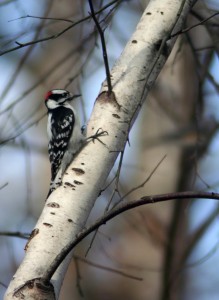 You don’t often see a flock of chickadees and titmice without also seeing the other members of their winter clique – the white-breasted nuthatch and the downy woodpecker. The downy, being more deliberate and cautious, was much easier to photograph than the other members of the merry troupe moving through the woods this afternoon. I heard them coming, mostly the chatter of the chickadees, long before they were in sight. The only bird missing was a brown creeper, but those are hard to find locally. The downy paused briefly to inspect the bark of this birch before drifting leisurely away with the rest of his associates.
You don’t often see a flock of chickadees and titmice without also seeing the other members of their winter clique – the white-breasted nuthatch and the downy woodpecker. The downy, being more deliberate and cautious, was much easier to photograph than the other members of the merry troupe moving through the woods this afternoon. I heard them coming, mostly the chatter of the chickadees, long before they were in sight. The only bird missing was a brown creeper, but those are hard to find locally. The downy paused briefly to inspect the bark of this birch before drifting leisurely away with the rest of his associates.
It’s thought that a mixed flock like this benefits the members in a few ways. The many eyes and ears may be better able to find predators or food. Each species is able to take advantage of its own niche within the habitat while helping other members of the flock to locate food. We see this at our backyard feeders; curious chickadees are often the first species to check out a new feeder, followed closely by titmice, and finally the more wary woodpeckers. I’ve read that downy woodpeckers use chickadees and titmice as sentinels in a mixed-species flock. I also listen for their high pitched *seeee* notes to know that there’s a hawk overhead.
The winter cliques will be breaking up before long as spring draws near and competition for territory and a mate becomes more important than the companionship of hungry friends. The demands of nesting and feeding a family must not leave time for much else. Until then, our familiar winter birds travel together and liven up the winter landscape with their whispered rumors of spring.
A stinker
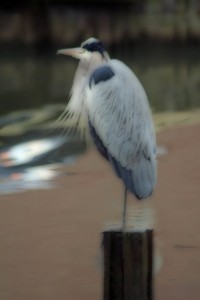 I can’t tear myself away from the coverage of Anna Nicole’s funeral long enough to put together a proper post tonight. Instead I’ll just pass along this link to Laura at Vitamin Sea. She’s in Florida and shares Mary’s affinity for GB Herons. I think she may even call them stinkers too. Someone turned one of her very nice photos of a GB Heron into a painting and she’s sharing the finished artwork on her blog today. She also has a link to the artist’s site and there’s more nice things to peruse there. Have a look.
I can’t tear myself away from the coverage of Anna Nicole’s funeral long enough to put together a proper post tonight. Instead I’ll just pass along this link to Laura at Vitamin Sea. She’s in Florida and shares Mary’s affinity for GB Herons. I think she may even call them stinkers too. Someone turned one of her very nice photos of a GB Heron into a painting and she’s sharing the finished artwork on her blog today. She also has a link to the artist’s site and there’s more nice things to peruse there. Have a look.
I took this awful photo towards the end of January; pulled off to the side of the road *a la Mary* and tried to keep the big lens from shaking too much while I hoped that someone wouldn’t crash into me. It could have been a really nice pic if I’d had a tripod, but setting that up surely would have scared him away. I love the way the telephoto lens distorted the background – too bad all my shaking also totally distorted the bird too. It hurts my eyes to look at it for too long, sort of the way looking at Anna Nicole’s pink-draped coffin all day hurts my eyes. Anyway, I’m just noticing that this guy had his pretty breeding plumes on in late January – what’s up with that?
Finding spring in the stars
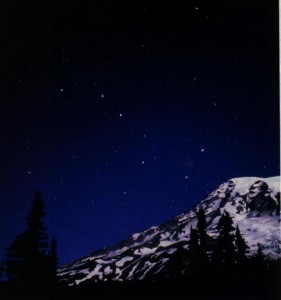 Anyone else in the mood for a little Borland? Here’s something a bit different about the late winter sky from Sundial of the Seasons:
Anyone else in the mood for a little Borland? Here’s something a bit different about the late winter sky from Sundial of the Seasons:
“Days lengthen, but the nights are still bright with the Winter stars, frosty and sharp in the darkness. The Big Bear, the Dipper, swings to the east in early evening, and the Little Bear walks across the sky, his upright tail tipped with the polestar. The Twins and the Charioteer are almost overhead, and the Pleiades ride high, toward the southwest. The Lion is in the east and the Whale in the west, both within reach of the horizon, reminders of Daniel and Jonah.
February thins away. Before another new moon hangs on the western horizon at dusk, March will be nearing its end and the Big Dipper will be overhead, or at least above the polestar, by midevening. The fang of the night chill will be dulled. Hylas will be shrilling in the lowlands, April at hand.
The seasons turn, as do the stars, and those who live with the wind and the sun understand the inevitability of their changes. The full moon fades the constellations and dims the Milky Way, but it does not halt their progression or change their place in the sky. Come April, and the Dipper stands above the polestar at evening, and buds begin to open. Come October, and the Dipper sweeps the evening horizon, and maple leaves turn to gold and Fall is upon us.
February has its pattern, but it is a shifting pattern, with movement and change, and progression. The sun lingers, the new moon sits on the hills, the early Dipper hangs to the east, and the bud waits on the branch.”
Most all of this is Greek to me. I can find the Big Dipper, and that helps me to locate the North Star, but beyond that I’m a foreigner in the land of the stars. The signs of spring found in the night sky are as lost to me as they are to a person who doesn’t know birds or the late winter woods. I’ve never had anyone to teach me the stars, and somehow I think learning about the night sky should happen in a romantic sort of way and on long quiet walks with the sound of the ocean in the distance, maybe; certainly not alone with the Peterson’s as my only teacher.
Do you know the stars? Who was your teacher? PG stories only, please!
😉
Note: Clicking on the photo links to a page which names some of the stars that make up the Big Dipper, I think. I grabbed the photo from their site, anyway. If you can recommend a good site, or book, please do!
Mid-week silliness
Is beauty enough?
I don’t know that this quote holds true for mute swans, but I do believe it to be true for most other things in the natural world. I think we’re more inclined to curiosity once some love and knowledge is gained, don’t you?
For all their beauty, mute swans are maligned by many for their aggressiveness. In many places their numbers have increased such that they are edging out native waterfowl and destroying aquatic vegetation. They are known to drive away least terns, skimmers, and native swans like the tundra from roosting and feeding areas.
The more you know about these elegant birds, the harder it is to look upon them as anything but pests. Like many other introduced or invasive species, the mute swan thrives, perhaps because of its great beauty, despite our knowing it so well.
Color(ful) for One Deep Breath
just beyond the brown hilltops
spring waits there
But not yet. I couldn’t take a step towards that hillside or the marsh beyond the scene I captured here. The ice-crusted snow made it all unreachable. Spring is there, over the hilltop, and after the thaw.
Let it snow!
Kitchen dancing
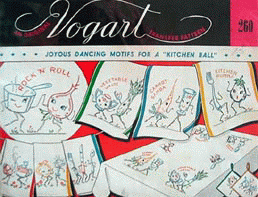 When I’m out and about running errands on Saturday afternoons I like to listen to The Saturday Show with Jonathan Schwartz on WNYC. It’s an interesting mix of Jazz, classical and American Standards with a little Neil Young mixed in for good measure. Not my normal choice in music, but every so often I hear something that just knocks my socks off and I appreciate being exposed to good music that I might not otherwise listen to. Today I heard a medley of In the Wee Small Hours/Leaving Again by jazz singer Kurt Elling – his first album will be released in April and while I don’t know that I’d buy the whole album, I’ll be sure to look for that track on iTunes.
When I’m out and about running errands on Saturday afternoons I like to listen to The Saturday Show with Jonathan Schwartz on WNYC. It’s an interesting mix of Jazz, classical and American Standards with a little Neil Young mixed in for good measure. Not my normal choice in music, but every so often I hear something that just knocks my socks off and I appreciate being exposed to good music that I might not otherwise listen to. Today I heard a medley of In the Wee Small Hours/Leaving Again by jazz singer Kurt Elling – his first album will be released in April and while I don’t know that I’d buy the whole album, I’ll be sure to look for that track on iTunes.
My favorite part of The Saturday Show is that he plays nearly a full hour of Frank Sinatra. Hearing Sinatra this way brings me back to when I was a kid and a similar radio show my mother listened to that played nothing but Sinatra standards on Saturday night. She loved his music and always tried to grab one of my big brothers for a dance around the kitchen. I smile thinking of it.
Other music that I learned to like growing up was whatever my older brothers were listening to. I know all the songs by The Eagles, Styx, Kansas, Boston, and Lynyrd Skynyrd. I got way more than my fill of Lynyrd Skynyrd; my brother Brian played the drums and had a band that used to practice in our rec room and they played Freebird and Sweet Home Alabama over and over again. I can’t exactly say that I smile remembering that!
What music reminds you of your childhood? What makes you want to grab someone for a twirl across the kitchen linoleum?
Hug a bee (or a moth, or an ant or…)
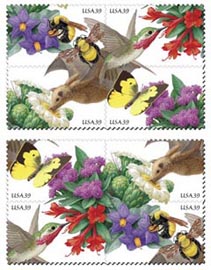 Pollinators are an essential part of a healthy ecosystem and play a significant role in the production of more than 150 food crops in the US. Wild and domestic bees do the majority of the work to provide us with apples and almonds and cranberries, but other invertebrates like butterflies, beetles, and flies, as well as vertebrates like birds and bats also play a role. In addition to increasing the productivity of food crops, pollinators are also responsible for the survival and reproduction of many native plant species.
Pollinators are an essential part of a healthy ecosystem and play a significant role in the production of more than 150 food crops in the US. Wild and domestic bees do the majority of the work to provide us with apples and almonds and cranberries, but other invertebrates like butterflies, beetles, and flies, as well as vertebrates like birds and bats also play a role. In addition to increasing the productivity of food crops, pollinators are also responsible for the survival and reproduction of many native plant species.
It’s easy to appreciate the beauty of flowers, but I’m fascinated to consider the myriad ways that flowers and pollinators have evolved together to ensure that plants produce offspring. The challenge to plants being that they’re stationary and can’t wander off to a singles bar on Friday night to be fertilized. Instead, they entice pollinators to come to them with scent and shape and color.
Populations of native pollinators are declining for the same reasons we know to affect other wildlife: habitat loss, pesticide use, pollution, poor agricultural practices, introduced species, etc – we’re all familiar with that list. It’s important to make people aware of the problem and the ways that they might help to mitigate the damage we do. I’d imagine that most flower and vegetable gardeners have some experience with pollinators, both positive and negative. It’s the people who have never grown a tomato or who are convinced that *nature* is out to get them that could benefit the most, in my opinion, from a basic understanding of plant biology and how it affects the food on our table and the landscape outside our front door.
The image above is the new *Pollination* stamp series from the US Postal Service due out in June of this year. “The intricate design of these beautiful stamps emphasizes the ecological relationship between pollinators and plants and suggests the biodiversity necessary to ensure the viability of that relationship.” A sure way to dress up the monthly bills.

